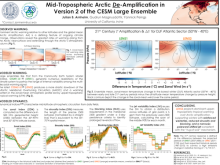Unique Mid-Tropospheric Arctic De-Amplification in Version 2 of the Community Earth System Model Large Ensemble Project (LENS2)
Julian
Arnheim
University of California, Irvine
Poster
The response of the polar jet stream to climate warming and rapid Arctic change is among the most sought-after uncertainties of changing general circulation, with marked importance to mid-latitude surface weather. While climate models effectively reproduce broad surface warming patterns, uncertainty persists in the relative dominance of warming maxima in the Arctic near-surface (AA; Arctic Amplification) and tropical upper-troposphere (UTW; Upper-Troposphere Tropical Warming). Given the bearing of these phenomena on jet behavior, it is crucial to explore the range of potential jet responses to warming out to 2100.
The latest generation of the Community Earth System Model (CESM) Large Ensemble project (LENS2) shows familiar warming patterns, with a peculiar signal of reduced Arctic mid-tropospheric warming compared to various reference means. The dampened Arctic warming at ~500-700 hPa, most prominent in the Atlantic sector and often accompanied by a secondary UTW in the subtropics, is absent from LENS1 and historical reanalysis (ERA5). The regional de-amplification may suggest: (i) remote atmospheric influence of the North Atlantic Warming Hole (NAWH) as is formed by greater slowing of the Atlantic Meridional Overturning Circulation (AMOC); (ii) a trend in the characteristics of Sudden Stratospheric Warming (SSW) events, which disrupt the polar vortex; and/or (iii) previous underestimation of the positive Arctic lapse-rate feedback.
This work investigates the dampened mid-tropospheric Arctic warming and associated dominance of UTW over AA in LENS2 through twenty-first century warming. Employing a series of mid-latitude diagnostics to daily fields in the early- to late-century, we outline discrepancies in mean flow between the large ensembles. Preliminary monthly-mean wind data support an intensified, lowered, and poleward-shifted polar jet stream in LENS2 in accordance with past understanding of the ‘tug-of-war’ mechanism. This analysis will explore potential changes in atmospheric variability and can guide future experiments in establishing causality between the mechanisms linked to non-uniform warming of the Arctic’s projected temperature profile.
The latest generation of the Community Earth System Model (CESM) Large Ensemble project (LENS2) shows familiar warming patterns, with a peculiar signal of reduced Arctic mid-tropospheric warming compared to various reference means. The dampened Arctic warming at ~500-700 hPa, most prominent in the Atlantic sector and often accompanied by a secondary UTW in the subtropics, is absent from LENS1 and historical reanalysis (ERA5). The regional de-amplification may suggest: (i) remote atmospheric influence of the North Atlantic Warming Hole (NAWH) as is formed by greater slowing of the Atlantic Meridional Overturning Circulation (AMOC); (ii) a trend in the characteristics of Sudden Stratospheric Warming (SSW) events, which disrupt the polar vortex; and/or (iii) previous underestimation of the positive Arctic lapse-rate feedback.
This work investigates the dampened mid-tropospheric Arctic warming and associated dominance of UTW over AA in LENS2 through twenty-first century warming. Employing a series of mid-latitude diagnostics to daily fields in the early- to late-century, we outline discrepancies in mean flow between the large ensembles. Preliminary monthly-mean wind data support an intensified, lowered, and poleward-shifted polar jet stream in LENS2 in accordance with past understanding of the ‘tug-of-war’ mechanism. This analysis will explore potential changes in atmospheric variability and can guide future experiments in establishing causality between the mechanisms linked to non-uniform warming of the Arctic’s projected temperature profile.

arnheim-julian-polar-poster.pdf
(4.85 MB)
